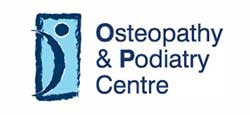Paediatrics (Children’s Feet)
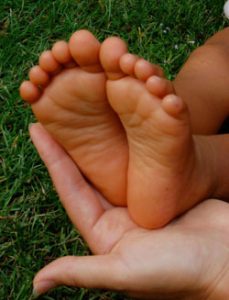
As parents we are all concerned about our children health and well being. If parents are concerned about their child’s feet they should always seek professional advice. Our podiatrists will provide a thorough assessment of the foot and gait, as well as footwear.
Often advice on footwear, shoe fitting, exercises and re-assurance is all that is required for children’s feet. Sometimes referral to an osteopath or a paediatric physiotherapist may be necessary. The podiatrist may ask you to bring your child for monitoring in 6-12 months to see how they develop and grow and when necessary start a treatment regime
To book an appointment call +65 6734 4236 or book online HERE
Flat Feet
Flat feet are often a big worry for parents and it often drives them to bring their child for assessment. However intervention is not always necessary for this condition for example in very young children flat feet can be normal.
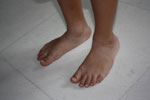 Our podiatrists will assess the age, weight, strength, muscles and gait as well as taking a full family and medical history before embarking on a plan with the parent. Often advice on footwear, shoe fitting, exercises and re-assurance is all that is required.
Our podiatrists will assess the age, weight, strength, muscles and gait as well as taking a full family and medical history before embarking on a plan with the parent. Often advice on footwear, shoe fitting, exercises and re-assurance is all that is required.
Intervention will be more likely necessary
- If the child has associated pains in the feet, legs, knees or hips
- If they fatigue more quickly or trip or fall more than their friends or siblings
- If there is strong family history of foot, knee and back problems.
In these cases orthotics may be necessary and sometimes referral to an osteopath or a paediatric physiotherapist.
If parents are concerned about their child’s feet they should always seek professional advice, as it is better for the fears to be unfounded than to discover, often too late, that intervention was required.
To book an appointment call +65 6734 4236 or book online HERE
In-toeing Gait
In-toeing gait, also known as pigeon toed, is where there is an abnormal excessively inward angle of the toes. In mild cases this is due to normal growth and rotations of the bones in the foot and leg and the child will probably grown out of it.
If it is more severe and the child is tripping and falling it is best to be assessed by a podiatrist. A bio-mechanical and gait analysis will be carried out and if necessary custom made orthotics. Referral may also be necessary to an osteopath or a physiotherapist.
To book an appointment call +65 6734 4236 or book online HERE
Shin Splints
Shin splints is a general term used for pain in the front of the lower leg. The most common cause of shins splints is medial tibial stress syndrome. The pain associated with shin splints is a result of fatigue and trauma to the muscle’s tendons where they attach themselves to the tibia. Poor footwear, foot posture and bio-mechanics can lead to instability, and in an effort to keep the foot, ankle and lower leg stable, the muscles exert a great force on the tibia. This excessive force can result in the tendons being partially torn away from the bone.
Shin splints can occur in adults and children alike but tend to occur in more active individuals. Treatment may involve biomechanical examination and gait analysis, massage, ultrasound and possibly custom made orthotics.
In children the pain can often be dismissed as ‘growing pains’ but if there is an obvious foot problem such as flat feet it is wise to get the child assessed by a podiatrist.
To book an appointment call +65 6734 4236 or book online HERE
Frequent Falls
Children who fall more frequently than normal may have problems associated with gait and/or footwear. If you are concerned please bring your child for a biomechanical and gait analysis. The podiatrist will also check you child’s footwear so please bring in examples of their regular footwear.
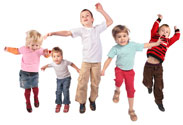
To book an appointment +65 6734 4236 or book online HERE
Hypermobility
Hypermobility is a condition in which there is more movement or mobility at a joint beyond the normal range of most peoples’ joints. This can happen at a specific region of the body or multiple joints of the body. Hypermobility is a common underlying factor in children with flat feet.
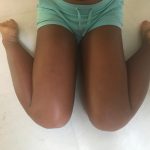 Children with hypermobility may also sit in the ‘W’ position. In this position, a child’s base of support is wider and their centre of gravity is lower, allowing for increased stability through the hips and trunk but it engages the core less so leading to weaker core muscles. It may also lead to in-toeing gait.
Children with hypermobility may also sit in the ‘W’ position. In this position, a child’s base of support is wider and their centre of gravity is lower, allowing for increased stability through the hips and trunk but it engages the core less so leading to weaker core muscles. It may also lead to in-toeing gait.
Another tell tale sign of hypermobility is ‘back bracing’ when standing. The can lead to problems such as rotational issues through the spine, pelvic rotation and functional leg length discrepancies.
 Symptoms of hypermobility can be frequent falls, lack of interest in sport and complaining of ‘tired legs’ in young children. In older children and also adults, symptoms can be poor posture, joint pain and stiffness, foot pain and gait abnormalities, poor hand writing, and back and muscle ache and strain.
Symptoms of hypermobility can be frequent falls, lack of interest in sport and complaining of ‘tired legs’ in young children. In older children and also adults, symptoms can be poor posture, joint pain and stiffness, foot pain and gait abnormalities, poor hand writing, and back and muscle ache and strain.
Orthotics can help with your child’s stability reducing falls and helping support the arch and weak ligaments.
To book an appointment call +65 6734 4236 or book online HERE

